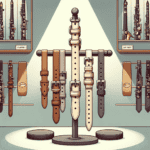Playing the clarinet requires comfort and proper support for a successful performance. A neck strap is an essential accessory that significantly contributes to this. A well-chosen clarinet neck strap offers comfort and helps minimize fatigue during extended practice sessions or performances. Let's explore the features and benefits of clarinet neck straps and how to select the best one for your needs.
The Importance of a Quality Neck Strap
A neck strap's main function is to support the clarinet, easing pressure on your fingers and reducing strain on your neck and back. Considering the clarinet's length and weight, particularly during long playing periods, a good neck strap can greatly improve your playing experience.
Here are some key advantages of using a high-quality neck strap:
- Comfort: A well-designed neck strap evenly distributes the instrument's weight across your body, reducing discomfort from supporting the clarinet solely with your hands.
- Better Focus: By addressing comfort, you can concentrate on your playing instead of physical strain. This allows for uninterrupted musical expression.
- Improved Performance: A good neck strap promotes better posture while playing, leading to enhanced breath support and sound production. Proper alignment helps create a more resonant tone.
Types of Clarinet Neck Straps
There are several types of neck straps available, each with unique features to cater to different player preferences:
| Strap Type | Material | Key Features |
|---|---|---|
| Standard Neoprene | Soft, stretchy neoprene | Comfort, durability, popular choice |
| Leather | High-quality leather | Longevity, support, elegance |
| Adjustable | Various | Customizable length, adaptable to playing posture |
| Ergonomic | Various | Body-contouring design, maximum comfort |
Choosing the Right Neck Strap
Selecting a neck strap involves several factors:
- Material: Pick a material that's comfortable against your skin and durable. Both neoprene and leather are excellent choices, each with its own benefits.
- Adjustability: A good neck strap should be adjustable to suit your height and playing posture. Ensure the strap can be customized for optimal alignment during play.
- Weight Distribution: Choose a strap that spreads weight evenly across your shoulders. This feature helps prevent discomfort and enables longer practice sessions.
Integrating the Neck Strap into Your Practice
After selecting the right neck strap for your clarinet, it's crucial to incorporate it effectively into your practice routine:
- Adjust and Test the Fit: Before playing, ensure the neck strap is properly adjusted. It should support your clarinet at a comfortable height without straining your neck or shoulders.
- Practice Posture Awareness: Stay mindful of your posture while playing. Good posture aids breath control and supports optimal playing technique.
- Build Your Endurance: Practice playing for extended periods while wearing the neck strap. This helps identify any discomfort or necessary adjustments in the strap's position.
Quality Instruments Enhance Your Experience
The quality of your instrument also affects how you experience playing with a neck strap. High-quality instruments, such as those from Martin Freres, can enhance your playing experience due to their superior craftsmanship. A well-made clarinet pairs well with a good neck strap, providing the support needed for longer playing sessions.
The right combination of a quality neck strap and a well-maintained instrument creates a synergy that allows players to reach their full potential. When you're comfortable and supported while playing, you can express yourself more freely through your music.
Care and Maintenance for Your Neck Strap
To maximize the lifespan of your neck strap, proper care is essential. Here are some tips:
- Cleaning: Regularly clean your neoprene or leather strap to remove sweat and dirt. This prevents odors and material deterioration over time.
- Storage: Store your neck strap in a cool, dry place away from direct sunlight. Avoid folding it in ways that could create creases or damage the material.
- Check for Wear and Tear: Routinely inspect the strap for signs of wear, especially at adjustable points or where it connects to the clarinet. If you notice any deterioration, consider replacing the strap.
As you continue your journey as a clarinetist, let the right neck strap enhance your playing experience while developing your skills and musical expression. The harmony between your instrument and accessories can positively shape your growth as a musician, guiding you towards musical achievement.







